Abstract
The carcinoembryonic antigen (CEA)-like genes are members of a large gene family which is part of the immunoglobulin superfamily. The CEA family is divided into two major subgroups, the CEA-subgroup and the pregnancy-specific glycoprotein (PSG)-subgroup. In the course of an effort to develop a set of overlapping cosmids spanning human chromosome 19, we identified 245 cosmids in a human chromosome 19 cosmid library (6-7X redundant) by hybridization with an IgC-like domain fragment of the CEA gene. A fluorescence-based restriction enzyme digest fingerprinting strategy was used to assemble 212 probe-positive cosmids, along with 115 additional cosmids from a collection of approximately 8,000 randomly selected cosmids, into five contigs. Two of the contigs contain CEA-subgroup genes while the remaining three contigs contain PSG-subgroup genes. These five contigs range in size from 100 kb to over 300 kb and span an estimated 1 Mb. The CEA-like gene family was determined by fluorescence in situ hybridization to map in the q13.1-q13.2 region of human chromosome 19. Analysis of the two CEA-subgroup contigs provided verification of the contig assembly strategy and insight into the organization of 9 CEA-subgroup genes.
Full text
PDF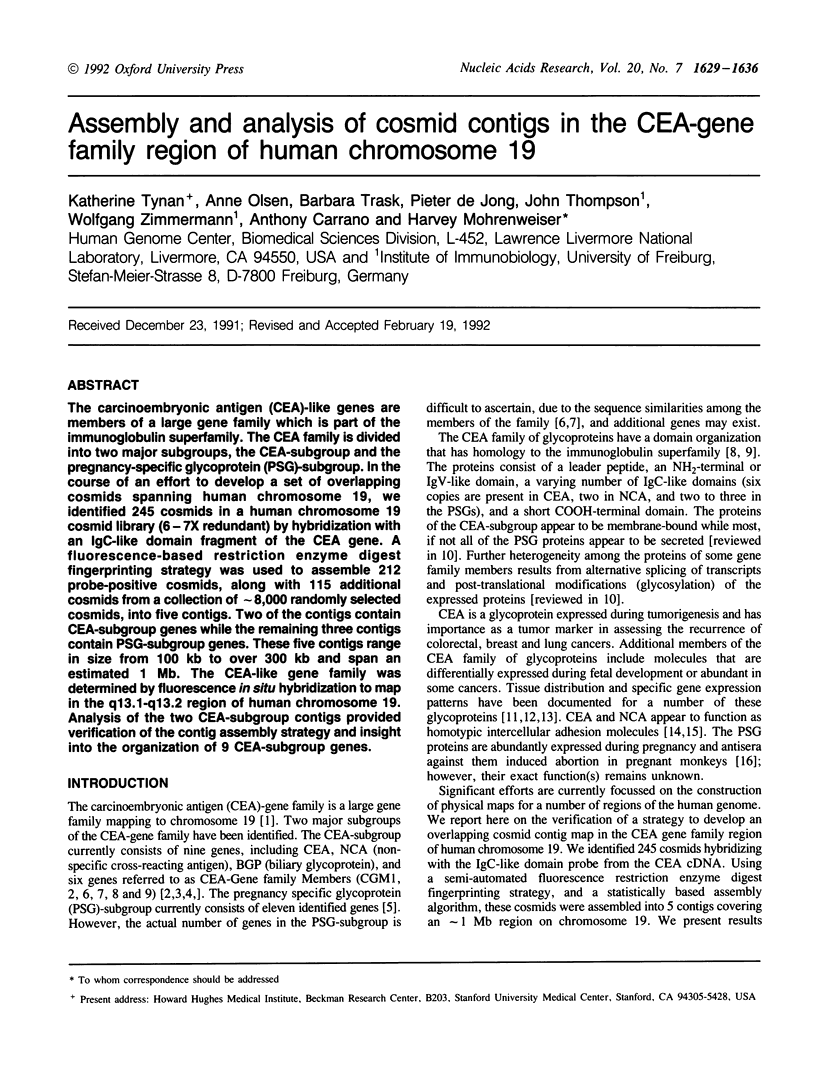
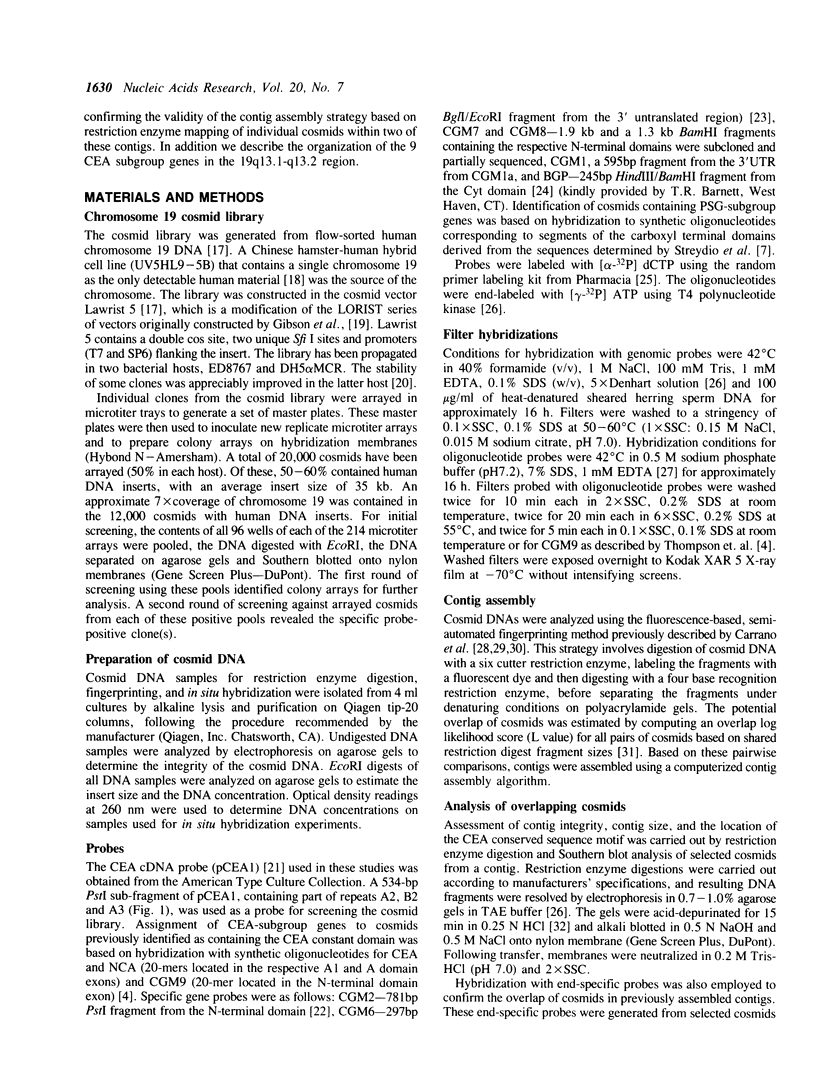
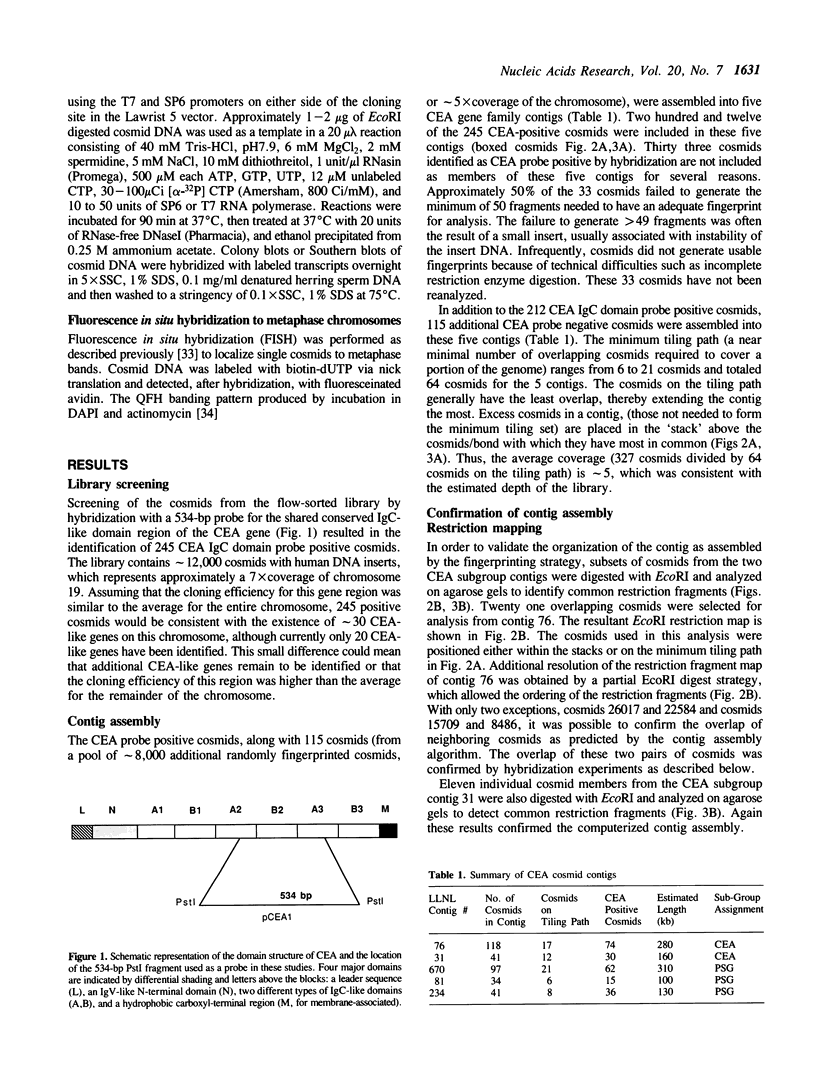
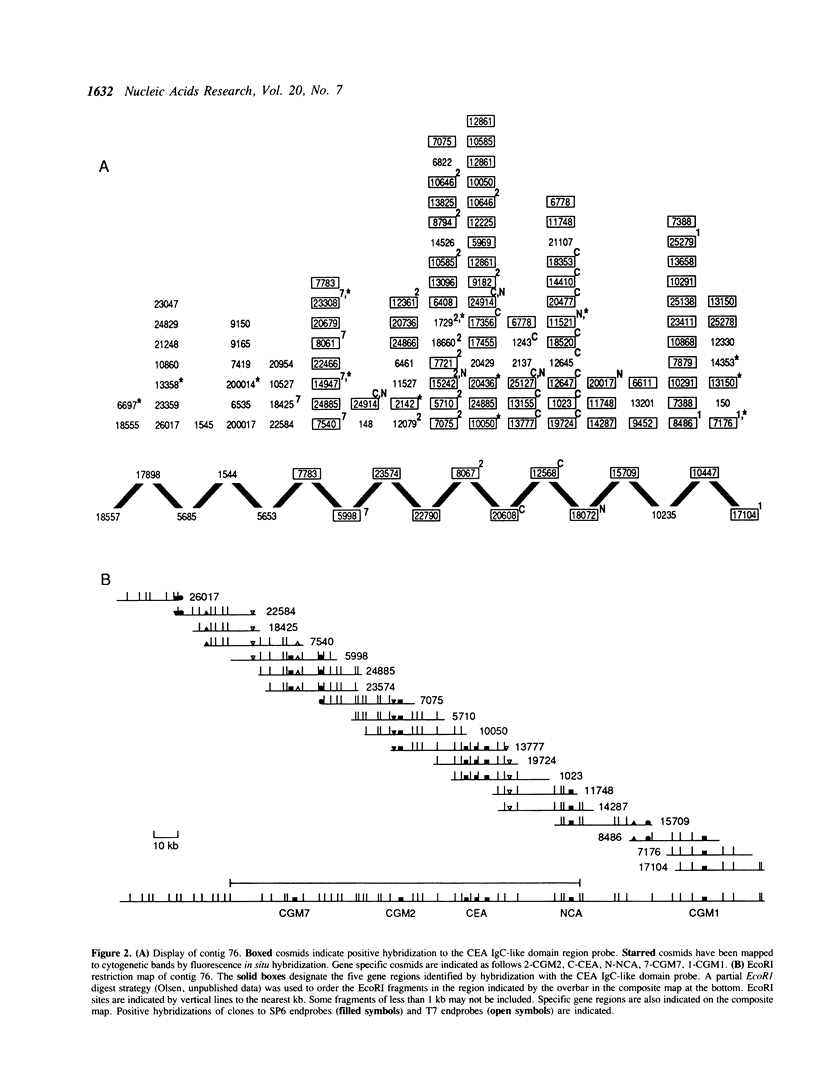
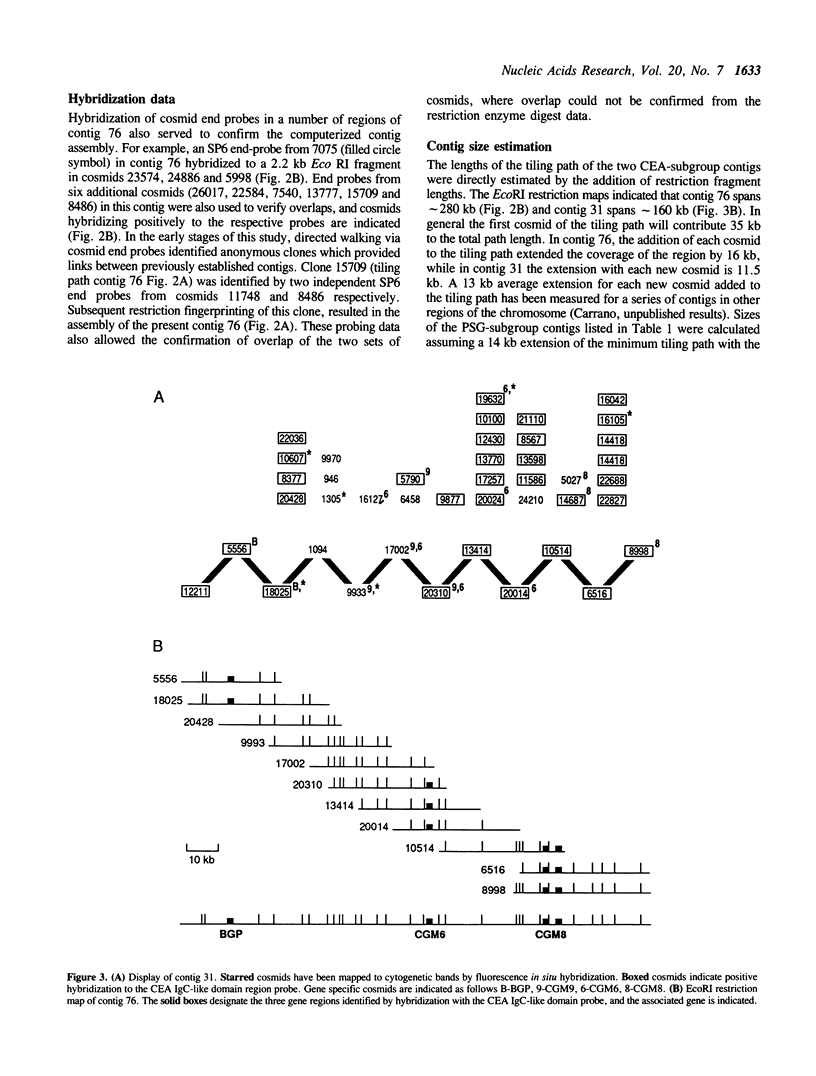
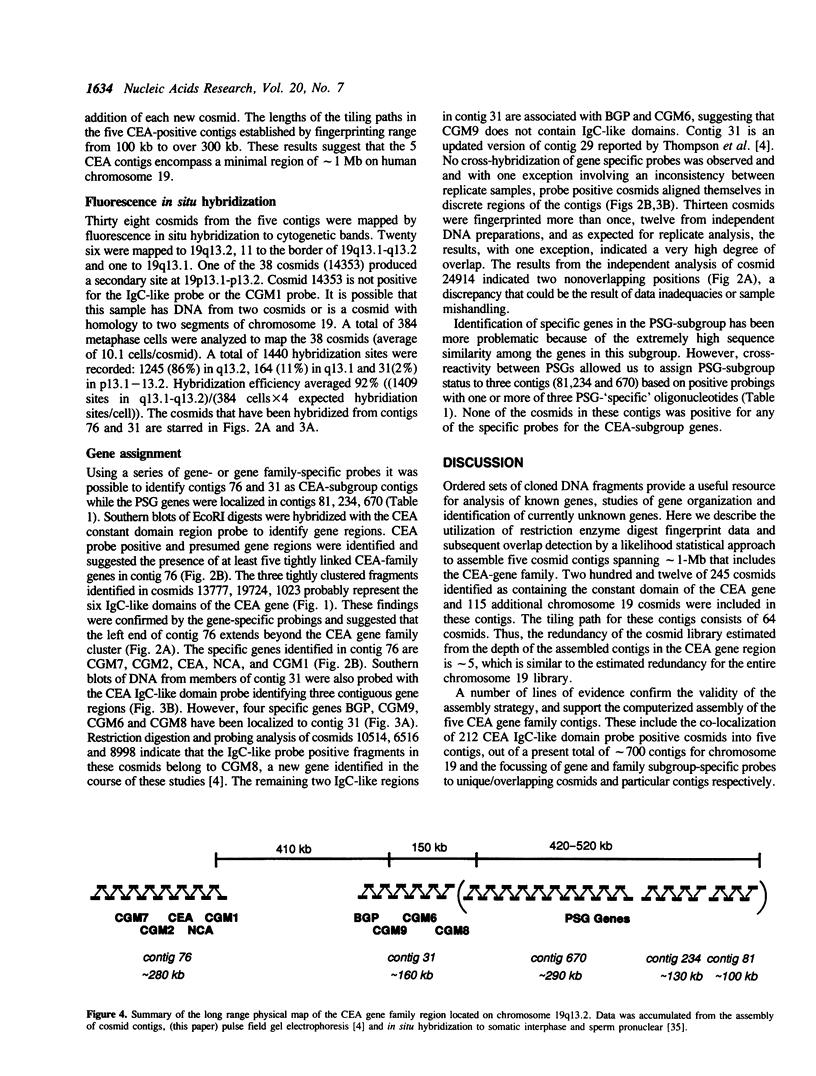
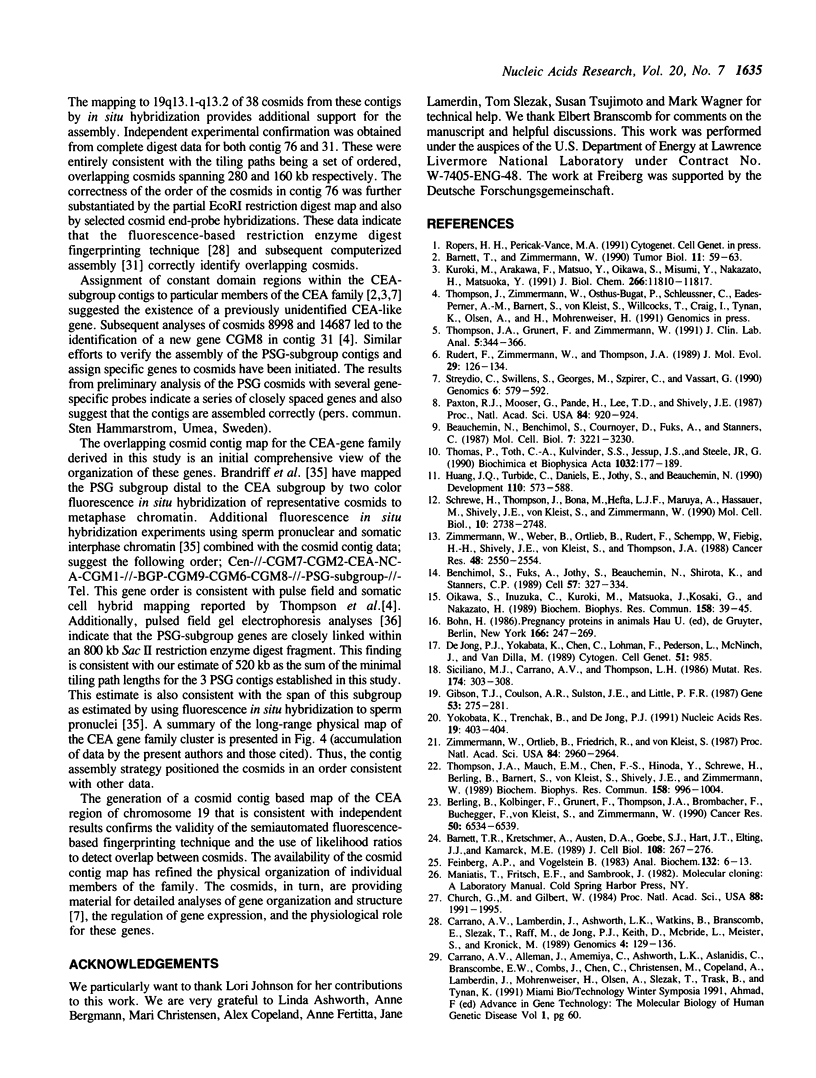
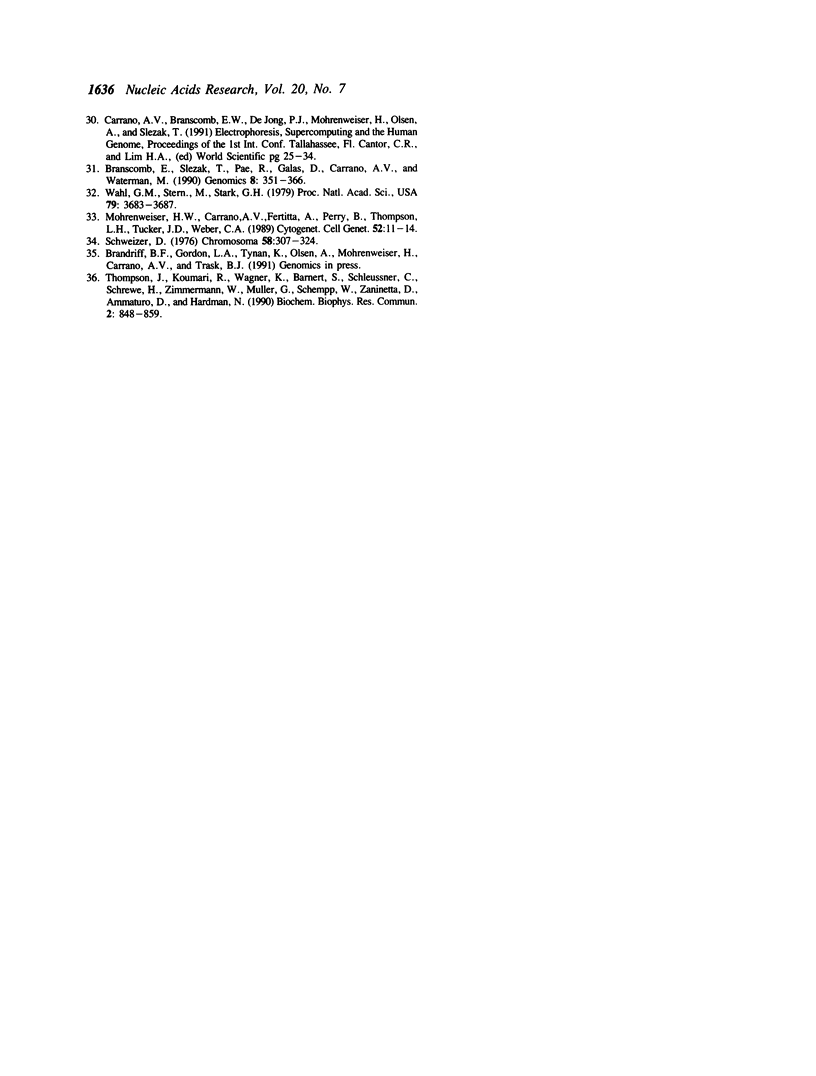
Selected References
These references are in PubMed. This may not be the complete list of references from this article.
- Barnett T. R., Kretschmer A., Austen D. A., Goebel S. J., Hart J. T., Elting J. J., Kamarck M. E. Carcinoembryonic antigens: alternative splicing accounts for the multiple mRNAs that code for novel members of the carcinoembryonic antigen family. J Cell Biol. 1989 Feb;108(2):267–276. doi: 10.1083/jcb.108.2.267. [DOI] [PMC free article] [PubMed] [Google Scholar]
- Barnett T., Zimmermann W. Workshop report: proposed nomenclature for the carcinoembryonic antigen (CEA) gene family. Tumour Biol. 1990;11(1-2):59–63. doi: 10.1159/000217643. [DOI] [PubMed] [Google Scholar]
- Beauchemin N., Benchimol S., Cournoyer D., Fuks A., Stanners C. P. Isolation and characterization of full-length functional cDNA clones for human carcinoembryonic antigen. Mol Cell Biol. 1987 Sep;7(9):3221–3230. doi: 10.1128/mcb.7.9.3221. [DOI] [PMC free article] [PubMed] [Google Scholar]
- Benchimol S., Fuks A., Jothy S., Beauchemin N., Shirota K., Stanners C. P. Carcinoembryonic antigen, a human tumor marker, functions as an intercellular adhesion molecule. Cell. 1989 Apr 21;57(2):327–334. doi: 10.1016/0092-8674(89)90970-7. [DOI] [PubMed] [Google Scholar]
- Berling B., Kolbinger F., Grunert F., Thompson J. A., Brombacher F., Buchegger F., von Kleist S., Zimmermann W. Cloning of a carcinoembryonic antigen gene family member expressed in leukocytes of chronic myeloid leukemia patients and bone marrow. Cancer Res. 1990 Oct 15;50(20):6534–6539. [PubMed] [Google Scholar]
- Branscomb E., Slezak T., Pae R., Galas D., Carrano A. V., Waterman M. Optimizing restriction fragment fingerprinting methods for ordering large genomic libraries. Genomics. 1990 Oct;8(2):351–366. doi: 10.1016/0888-7543(90)90293-4. [DOI] [PubMed] [Google Scholar]
- Carrano A. V., Lamerdin J., Ashworth L. K., Watkins B., Branscomb E., Slezak T., Raff M., de Jong P. J., Keith D., McBride L. A high-resolution, fluorescence-based, semiautomated method for DNA fingerprinting. Genomics. 1989 Feb;4(2):129–136. doi: 10.1016/0888-7543(89)90291-7. [DOI] [PubMed] [Google Scholar]
- Church G. M., Gilbert W. Genomic sequencing. Proc Natl Acad Sci U S A. 1984 Apr;81(7):1991–1995. doi: 10.1073/pnas.81.7.1991. [DOI] [PMC free article] [PubMed] [Google Scholar]
- Feinberg A. P., Vogelstein B. A technique for radiolabeling DNA restriction endonuclease fragments to high specific activity. Anal Biochem. 1983 Jul 1;132(1):6–13. doi: 10.1016/0003-2697(83)90418-9. [DOI] [PubMed] [Google Scholar]
- Gibson T. J., Coulson A. R., Sulston J. E., Little P. F. Lorist2, a cosmid with transcriptional terminators insulating vector genes from interference by promoters within the insert: effect on DNA yield and cloned insert frequency. Gene. 1987;53(2-3):275–281. doi: 10.1016/0378-1119(87)90016-3. [DOI] [PubMed] [Google Scholar]
- Huang J. Q., Turbide C., Daniels E., Jothy S., Beauchemin N. Spatiotemporal expression of murine carcinoembryonic antigen (CEA) gene family members during mouse embryogenesis. Development. 1990 Oct;110(2):573–588. doi: 10.1242/dev.110.2.573. [DOI] [PubMed] [Google Scholar]
- Kuroki M., Arakawa F., Matsuo Y., Oikawa S., Misumi Y., Nakazato H., Matsuoka Y. Molecular cloning of nonspecific cross-reacting antigens in human granulocytes. J Biol Chem. 1991 Jun 25;266(18):11810–11817. [PubMed] [Google Scholar]
- Mohrenweiser H. W., Carrano A. V., Fertitta A., Perry B., Thompson L. H., Tucker J. D., Weber C. A. Refined mapping of the three DNA repair genes, ERCC1, ERCC2, and XRCC1, on human chromosome 19. Cytogenet Cell Genet. 1989;52(1-2):11–14. doi: 10.1159/000132829. [DOI] [PubMed] [Google Scholar]
- Oikawa S., Inuzuka C., Kuroki M., Matsuoka Y., Kosaki G., Nakazato H. Cell adhesion activity of non-specific cross-reacting antigen (NCA) and carcinoembryonic antigen (CEA) expressed on CHO cell surface: homophilic and heterophilic adhesion. Biochem Biophys Res Commun. 1989 Oct 16;164(1):39–45. doi: 10.1016/0006-291x(89)91679-3. [DOI] [PubMed] [Google Scholar]
- Paxton R. J., Mooser G., Pande H., Lee T. D., Shively J. E. Sequence analysis of carcinoembryonic antigen: identification of glycosylation sites and homology with the immunoglobulin supergene family. Proc Natl Acad Sci U S A. 1987 Feb;84(4):920–924. doi: 10.1073/pnas.84.4.920. [DOI] [PMC free article] [PubMed] [Google Scholar]
- Rudert F., Zimmermann W., Thompson J. A. Intra- and interspecies analyses of the carcinoembryonic antigen (CEA) gene family reveal independent evolution in primates and rodents. J Mol Evol. 1989 Aug;29(2):126–134. doi: 10.1007/BF02100111. [DOI] [PubMed] [Google Scholar]
- Schrewe H., Thompson J., Bona M., Hefta L. J., Maruya A., Hassauer M., Shively J. E., von Kleist S., Zimmermann W. Cloning of the complete gene for carcinoembryonic antigen: analysis of its promoter indicates a region conveying cell type-specific expression. Mol Cell Biol. 1990 Jun;10(6):2738–2748. doi: 10.1128/mcb.10.6.2738. [DOI] [PMC free article] [PubMed] [Google Scholar]
- Schweizer D. Reverse fluorescent chromosome banding with chromomycin and DAPI. Chromosoma. 1976 Nov 29;58(4):307–324. doi: 10.1007/BF00292840. [DOI] [PubMed] [Google Scholar]
- Siciliano M. J., Carrano A. V., Thompson L. H. Assignment of a human DNA-repair gene associated with sister-chromatid exchange to chromosome 19. Mutat Res. 1986 Aug;174(4):303–308. doi: 10.1016/0165-7992(86)90051-5. [DOI] [PubMed] [Google Scholar]
- Streydio C., Swillens S., Georges M., Szpirer C., Vassart G. Structure, evolution and chromosomal localization of the human pregnancy-specific beta 1 glycoprotein gene family. Genomics. 1990 Apr;6(4):579–592. doi: 10.1016/0888-7543(90)90492-d. [DOI] [PubMed] [Google Scholar]
- Thomas P., Toth C. A., Saini K. S., Jessup J. M., Steele G., Jr The structure, metabolism and function of the carcinoembryonic antigen gene family. Biochim Biophys Acta. 1990 Dec 11;1032(2-3):177–189. doi: 10.1016/0304-419x(90)90003-j. [DOI] [PubMed] [Google Scholar]
- Thompson J. A., Grunert F., Zimmermann W. Carcinoembryonic antigen gene family: molecular biology and clinical perspectives. J Clin Lab Anal. 1991;5(5):344–366. doi: 10.1002/jcla.1860050510. [DOI] [PubMed] [Google Scholar]
- Thompson J. A., Mauch E. M., Chen F. S., Hinoda Y., Schrewe H., Berling B., Barnert S., von Kleist S., Shively J. E., Zimmermann W. Analysis of the size of the carcinoembryonic antigen (CEA) gene family: isolation and sequencing of N-terminal domain exons. Biochem Biophys Res Commun. 1989 Feb 15;158(3):996–1004. doi: 10.1016/0006-291x(89)92821-0. [DOI] [PubMed] [Google Scholar]
- Thompson J., Koumari R., Wagner K., Barnert S., Schleussner C., Schrewe H., Zimmermann W., Müller G., Schempp W., Zaninetta D. The human pregnancy-specific glycoprotein genes are tightly linked on the long arm of chromosome 19 and are coordinately expressed. Biochem Biophys Res Commun. 1990 Mar 16;167(2):848–859. doi: 10.1016/0006-291x(90)92103-7. [DOI] [PubMed] [Google Scholar]
- Wahl G. M., Stern M., Stark G. R. Efficient transfer of large DNA fragments from agarose gels to diazobenzyloxymethyl-paper and rapid hybridization by using dextran sulfate. Proc Natl Acad Sci U S A. 1979 Aug;76(8):3683–3687. doi: 10.1073/pnas.76.8.3683. [DOI] [PMC free article] [PubMed] [Google Scholar]
- Yokobata K., Trenchak B., de Jong P. J. Rescue of unstable cosmids by in vitro packaging. Nucleic Acids Res. 1991 Jan 25;19(2):403–404. doi: 10.1093/nar/19.2.403. [DOI] [PMC free article] [PubMed] [Google Scholar]
- Zimmermann W., Ortlieb B., Friedrich R., von Kleist S. Isolation and characterization of cDNA clones encoding the human carcinoembryonic antigen reveal a highly conserved repeating structure. Proc Natl Acad Sci U S A. 1987 May;84(9):2960–2964. doi: 10.1073/pnas.84.9.2960. [DOI] [PMC free article] [PubMed] [Google Scholar]
- Zimmermann W., Weber B., Ortlieb B., Rudert F., Schempp W., Fiebig H. H., Shively J. E., von Kleist S., Thompson J. A. Chromosomal localization of the carcinoembryonic antigen gene family and differential expression in various tumors. Cancer Res. 1988 May 1;48(9):2550–2554. [PubMed] [Google Scholar]


